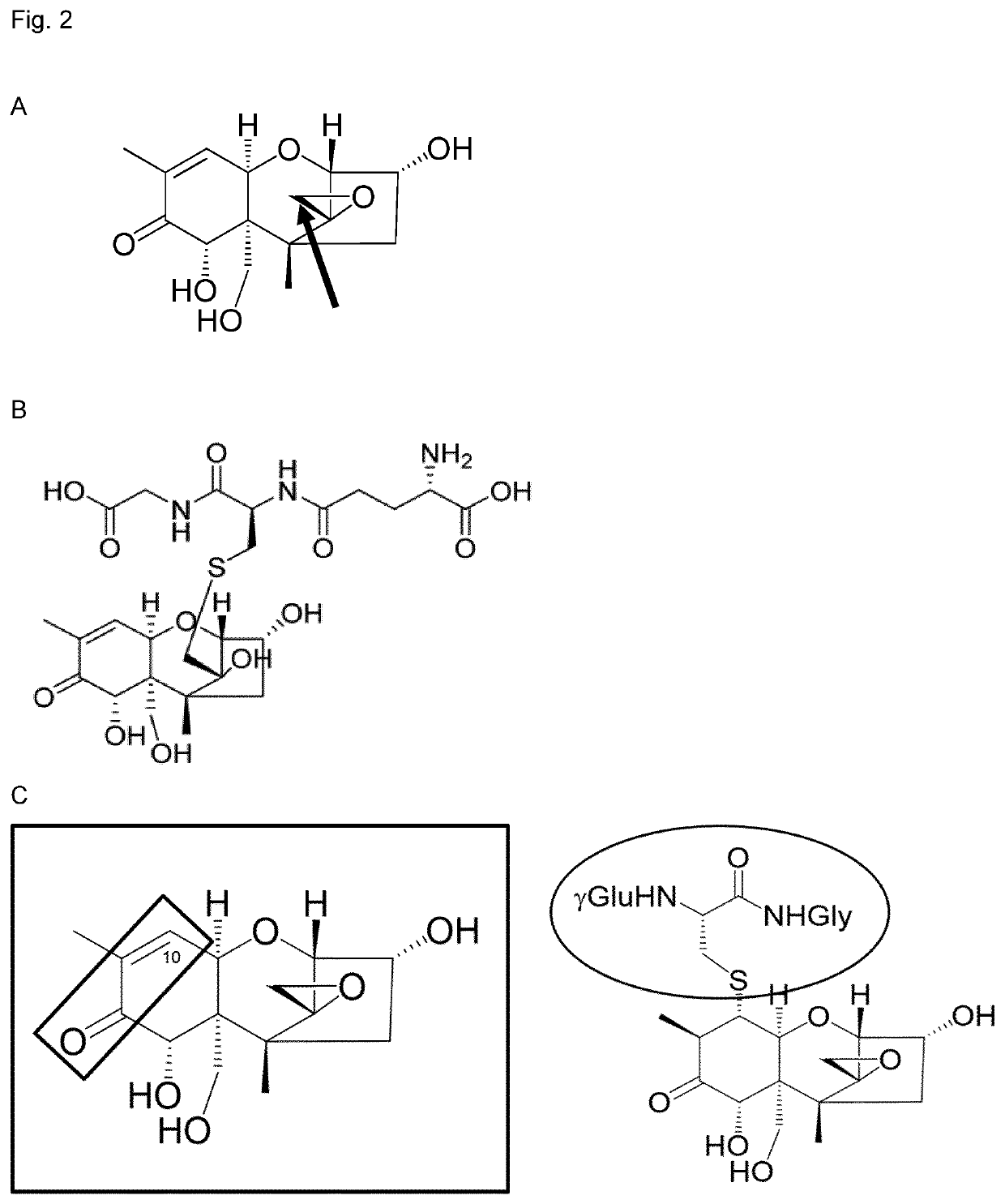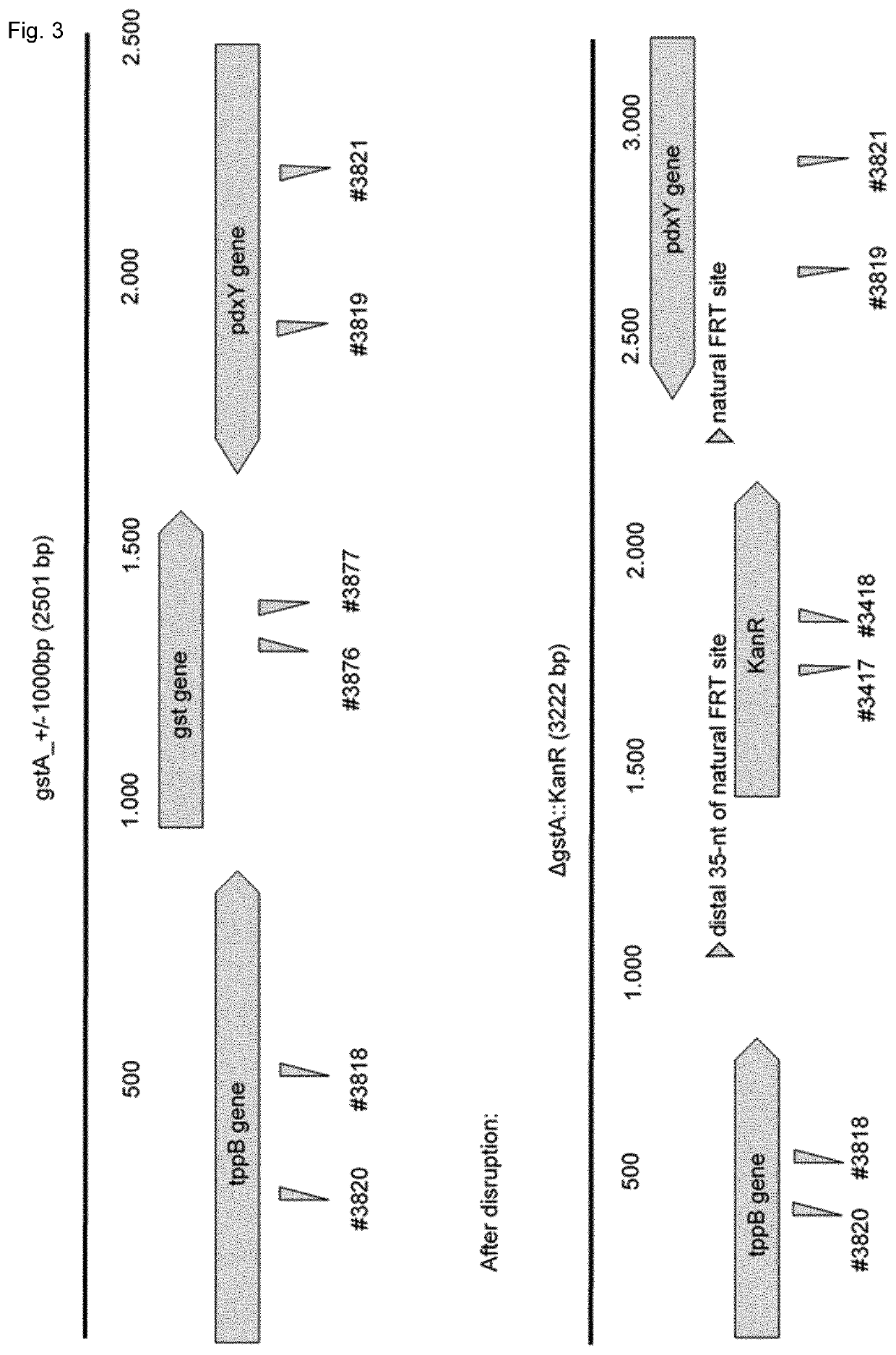Method for biotransformation of trichothecenes
a technology of trichothecene and biotransformation, which is applied in the direction of transferases, peptide sources, enzymology, etc., can solve the problems of no gene cloned, no gene has been cloned, and harm to hematopoietic organs and immune function
- Summary
- Abstract
- Description
- Claims
- Application Information
AI Technical Summary
Benefits of technology
Problems solved by technology
Method used
Image
Examples
example 1
Construction of the Expression Host
[0169]To be able to detect activity of a plant GST in a standard colorimetric assay a suitable E. coli host strain was constructed in which the endogenous GST gene (gstA) showing activity with the standard substrate (chloro-2,4-dinitrobenzene (CDNB)) of a colorimetric assay was inactivated. The gstA gene in the T7 polymerase based E. coli expression host “T7 Express” was disrupted as follows: First the plasmid pDK46 (with a temperature sensitive replication origin, and an arabinose inducible phage lambda recombination system (γβ exo) obtained from strain BW25113 / pKD46 (http: / / cgsc2.biology.yale.edu / Strain.php?ID=68099) was introduced into the expression strain T7 express. Arabinose induced competent cells were then transformed with a PCR product obtained from the gstA mutant strain JW1627-1 from the systematic knockout collection of E. coli (http: / / cgsc2.biology.yale.edu / Strain.php?ID=107667). The PCR product obtained with flanking primers (Del_gst...
example 2
Cloning and -Expression of GST Candidates
[0173]Candidates were cloned into E. coli expression vector pCA02 that encodes for an N-terminal 6× His tag and maltose binding domain. The vector carries a ColE1 origin, an ampicillin marker, a copy of the lac repressor and a T7 promoter and lac operator sequence.
[0174]The empty vector pCA02 was used as negative control.
Cloning of TrGST-C02
Wheat Glutathione S-Transferase
[0175]TRIAE_CS42_1DL_TGACv1_062916_AA0221650 was amplified from genomic DNA of Chinese Spring Wheat with primers TrGST-C02_upstr_fw and TrGST-C02_3′UTR_rv and cloned into pMiniT (NEB® PCR Cloning Kit). Exon 1 was amplified with primers TrGST-C02_GA-E1-fw and TrGST-C02_GA-E1-rv, exon 2 was amplified with primers TrGST-C02_GA-E2-fw and TrGST-C02_GA-E2-rv from the pMiniT clone. A fusion PCR was done with primers TrGST-C02_GA-E1-fw and TrGST-C02_GA-E2-rv. The PCR product was digest with Ndel / EcoRl and ligated into pCA02 digested with the same enzymes.
Cloning of TrGST-C12
Wheat Glu...
example 3
[0193]It was shown that TrGST-C02 and TrGST-C12 can also open the epoxide of Type A and macrocyclic (type D) trichothecenes. The following compounds lack the conjugated C8-keto feature of type B trichothecenes (required for Michael adduct formation), the adduct formation is therefore due to epoxide opening. Calculations of the expected masses of adducts with the respective compounds are given in the following tables.
TABLE 5neutralNameformulaCHNOSmass[M + H]+T-2C24H34O9243409466.2203467.2276GSHC10H17N3O6S1017361307.0838308.0911T-2-34513151773.3041774.3114GSH
TABLE 6neutralNameformulaCHNOSmass[M + H]+Tricho-C17H24O417244292.1675293.1747derminGSHC10H17N3O6S1017361307.0838308.0911TCM-27413101599.2513600.2585GSH
TABLE 7neutralNameformulaCHNOSmass[M + H]+RoridinC29H40O929409532.2672533.2745AGSHC10H17N3O6S1017361307.0838308.0911ROA-39573151839.3510840.3403GSH
PUM
| Property | Measurement | Unit |
|---|---|---|
| Fraction | aaaaa | aaaaa |
| Fraction | aaaaa | aaaaa |
| Fraction | aaaaa | aaaaa |
Abstract
Description
Claims
Application Information
 Login to View More
Login to View More - R&D
- Intellectual Property
- Life Sciences
- Materials
- Tech Scout
- Unparalleled Data Quality
- Higher Quality Content
- 60% Fewer Hallucinations
Browse by: Latest US Patents, China's latest patents, Technical Efficacy Thesaurus, Application Domain, Technology Topic, Popular Technical Reports.
© 2025 PatSnap. All rights reserved.Legal|Privacy policy|Modern Slavery Act Transparency Statement|Sitemap|About US| Contact US: help@patsnap.com



